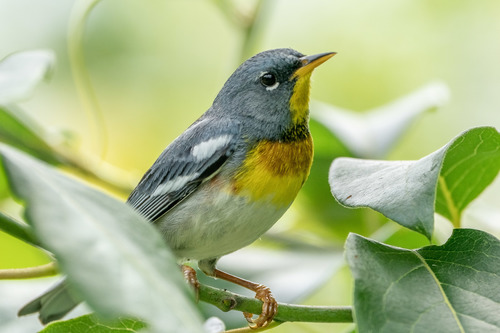
Northern Parula
The Northern Parula (Setophaga americana) is a small, vibrantly colored wood-warbler that breeds in eastern North America. Known for its distinctive buzzy trill and preference for nesting in hanging strands of epiphytes, it plays a crucial role in controlling insect populations within its forest habitat. This species is not only a jewel of the eastern woodlands but also holds a unique ecological niche, often associated with specific types of old-growth forests and riparian zones.
10.8-12 cm
Length
16-18 cm
Wingspan
Least Concern
Conservation Status
Distribution
Breeds across eastern North America, from southern Canada to the Gulf Coast. Winters in southern Florida, the Caribbean, and Central America. Migratory, with some populations undertaking long trans-Gulf flights.
Lifespan
Up to 7 years in the wild, though typical lifespan is likely shorter.
Northern Parula's Habitat
Habitat Types
Mature deciduous forests, Mixed coniferous-deciduous forests, Riparian woodlands, Swamp forests
Climate Zones
Temperate, Subtropical
Adaptations
Often associated with specific epiphytes for nesting, such as Usnea (beard lichen) in the north and Tillandsia (Spanish moss) in the south. This dependence can make them vulnerable to habitat changes that affect these epiphytes.
Variations
Two subspecies are generally recognized, differing slightly in plumage and size, one primarily in the northern part of the range and the other in the southern.
Appearance
Breeding Plumage
Males in breeding plumage have blue-gray upperparts, a yellow breast with a distinct orange and black band, and two white wing bars. Females are similar but duller. Nonbreeding plumage is less vibrant, with a more diffuse breast band.
Seasonal Feather Changes
Brighter plumage during breeding season, fading slightly in the non-breeding season.
Sex Based Plumage Differences
Males are more brightly colored, especially during breeding season, with a more defined breast band.
Notable Features
Broken white eye-ring, Yellow throat and breast, Two prominent white wing bars
Diet and Feeding
Primary Foods
Insects, Spiders, Caterpillars, Beetles
Foraging Behavior
Gleans insects from foliage, often hovering briefly. Forages actively in the mid to upper levels of trees and shrubs.
Specializations
Their small size and agility allow them to forage on the outer branches and leaves where larger birds may struggle.
Seasonal Diet Variations
Primarily insectivorous during breeding season. May supplement diet with small berries and seeds during migration and winter.
Behavior
Social Structure
Generally solitary or in pairs during breeding season. May form small mixed-species flocks during migration and winter.
Communication
Buzzy, ascending trill song (primary song), Chip notes for contact calls, Males will sing to defend the territory.
Migration
Nocturnal migrant. Undertakes significant migrations between breeding and wintering grounds, often crossing large bodies of water.
Territorial or Group Behaviors
Males are territorial during the breeding season, defending nesting and foraging areas. Territories are relatively small.
Conservation
Threats
Habitat loss and degradation (both breeding and wintering grounds), Loss of epiphytes due to air pollution, Collisions with buildings during migration, Pesticide use impacting insect prey
Protection Programs
General migratory bird protections (e.g., Migratory Bird Treaty Act in the US), Habitat conservation efforts in some areas
Local National Laws
Protected under the Migratory Bird Treaty Act in the United States.
Population Trend
Generally stable, although some regional declines have been noted.
Population Estimates
Global population estimated to be around 18 million.
Interesting Facts
Northern Parulas are highly dependent on epiphytes for nesting.
This makes them a good indicator species for forest health, particularly the presence of old-growth characteristics.
They are one of the smallest wood-warblers in North America.
Their small size allows them to access food resources in the outer canopy that larger birds cannot reach.
The name "Parula" comes from a diminutive form of *Parus*, the genus that includes titmice.
Although it is not closely related to titmice, the name likely refers to its small size.
Faqs about Northern Parula
What is the best way to attract Northern Parulas to my yard?
Providing a diverse habitat with native trees and shrubs, especially those that support insect populations, can help. Maintaining areas with epiphytes (if appropriate for your region) is also beneficial.
How can I tell a male Northern Parula from a female?
Males have a more distinct orange and black band across their yellow breast, while females have a duller, less defined band.
Where do Northern Parulas go in the winter?
They migrate to southern Florida, the Caribbean, and Central America.
How long do baby parulas stay in the nest?
The nestlings will fledge in approximately 10-11 days.
Copyright @ Nature Style Limited. All Rights Reserved.
 English
English